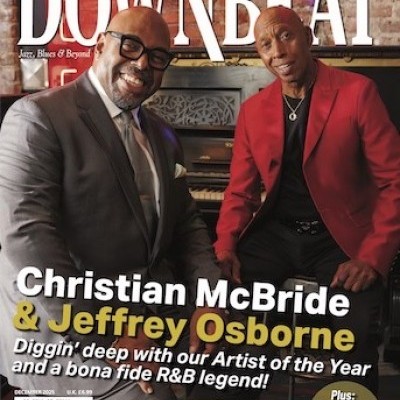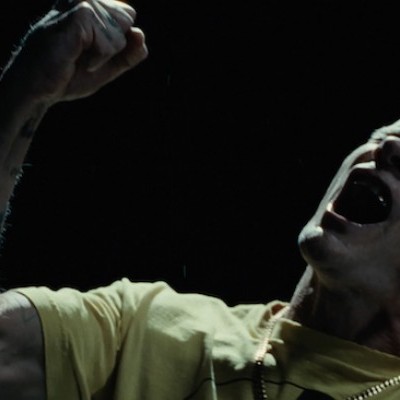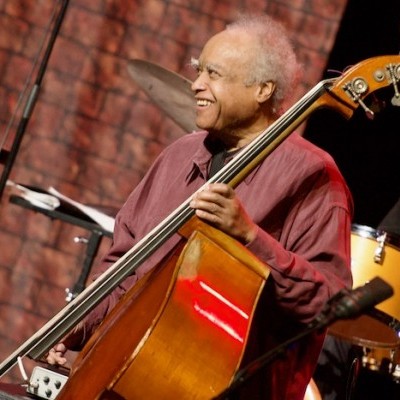Dec 9, 2025 12:28 PM
In Memoriam: Gordon Goodwin, 1954–2025
Gordon Goodwin, an award-winning saxophonist, pianist, bandleader, composer and arranger, died Dec. 8 in Los Angeles.…

“At the end of the day, once you’ve run out of differences, we’re left with similarities,” Collier says. “Cultural differences are mitigated through 12 notes.”
(Photo: Michael Jackson)DownBeat has a long association with the Midwest Clinic International Band and Orchestra Conference, the premiere global gathering for instrumental music educators and students for the past eight decades. Attracting approximately 17,000 attendees annually from 50 states and 40 countries, the Chicago-based conference has a history of presenting some of the world’s most accomplished instrumental artists at its Midwest Jazz Interview sessions. These live interviews have featured the likes of Ramsey Lewis, Kirk Whalum, Arturo Sandoval and legendary Cuban conguero Candido, among numerous others, over the years. Many of those always-vibrant conversations have been hosted by DownBeat writers and editors, and have subsequently appeared in the pages of this magazine.
Last December, 27-year-old saxophonist, composer and instigator Isaiah Collier held forth, disseminating beyond-his-years wisdom.
A remarkable talent, Collier surged into the rankings when still at high school in Chicago. There’s equilibrium to his persona despite a dizzying work ethic.
Collier’s longform responses during this interview, introduced by Midwest board member Dick Dunscomb and held at Chicago’s historic McCormick Place convention center, have been edited for continuity and space.
Michael Jackson: Your latest album, The World Is On Fire, was recently released on Division 81 Records, chasing up The Almighty, which was recorded the same week, with guests Dee Alexander and Ari Brown. You presented your ambitious music and dance dramatization The Story of 400 Years at Chicago’s DuSable Black History Museum, with assistance from the Steve Jobs Foundation, and you’ve just returned from Paris after guesting on TSF Radio. I remember when, still a student at ChiArts High School, you played the Chicago Jazz Festival in a wide-brimmed cowboy hat. Stretching out on a calypso, you were clearly aware that you had something cooking. How was it that you knew, so early, you were one of the so-called “Chosen Few” [the name of one of Collier’s bands]? Does that come from pushy parents, God-given talent or just diligent study?
Isaiah Collier: A mix of all three, but I think, specifically with the last few projects, what has been imminent for me is “purpose.” I had the chance to hang with a kora musician in London in September who was very diligent with his practice. “You have to understand I came from 79 generations of kora musicians,” he told me. Despite a host of other aspirations, he’d decided, “This is what I am supposed to do.”
Funnily enough, I was the last in my family to get into music. My brother Jeremiah [who currently plays with Stanley Clarke] was playing a whole drum set at age 2. My older brother used to play music, too. I thought, “That’s cool, but just because they’re doing it doesn’t mean I have to.” But no matter how far I tried to get away from music, it kept showing back up. Going to church, watching concerts and paying attention to all aspects of performance. You go to Orchestra Hall, see musicians doing their thing but then how’s is this one guy, the conductor, keeping all the pieces together. You start thinking, “What would my participation in the music look like? If it’s only reading this part, then what’s the point of all of this?”
Jackson: Circular breathing allows you to sustain long, relentless lines. Sonny Rollins learned the technique from a saxophonist nicknamed “One-Note Scotty.” How did you develop seamless skills there? Did it take long?
Collier: It’s a funny story. My father would talk about a saxophonist on the scene called Art Porter Jr. He came from Arkansas, a protégé of Pharoah Sanders.
Jackson: Yes, famous for his arrest for performing in nightclubs as a teenager, which led to [then Arkansas Attorney General] Bill Clinton introducing the “Art Porter Bill,” after which minors accompanied by legal guardians in clubs in the state were cool.
Collier: Exactly, he was also Bill Clinton’s godson. Before I discovered Rahsaan Roland Kirk, I saw videos of this guy playing two horns at once. Also, he was able to streamline the airflow, and I thought, “What is that?” My dad said, “That’s circular breathing, it may take you awhile,” and bet me that I could figure it out in my freshman year. Somebody said, “Get a straw, and a glass of water, keep blowing and keep the bubbles going.” I took it to the horn but couldn’t sustain it. Just like any technique, especially long tones, you have to practice. Four-bar phrase, double to eight, then 16. Work with the metronome, how fast, how slow? You’re adding a new set of muscle groups. Then I met James Carter who knew how to cycle breathe, and that was a whole other thing. Then I started working with Vincent Davis and through Vincent finally got to study with Roscoe Mitchell. Our first lesson was just one note, for 13 minutes straight! I was thinking, “How’s this guy still going?!” Then, about five minutes in, he started shaking a little. He took out his teeth [laughs] and I thought, “that’s not fair, I gotta keep going!” [laughter]
Jackson: Your deployment of mini-percussion owes a debt to the arch minimalist procedures of Mitchell’s Art Ensemble of Chicago, too, and the AACM, it’s fair to suggest?
Collier: 100%! When I first worked with Vincent, who trained many of the most capable musicians coming out of Chicago — Junius Paul, Justin Dillard, Corey Wilkes, Isaiah Spencer, Emma Dayhuff, Jeremiah Hunt, Marquis Hill, Maurice Brown, it was teaching us how to be in the now.
After your solo, you think you’re done but the music is still going. Bringing the little instruments in, you are always participating, bringing in the micro aspect, shifting the atomic matter. With tempered bells you can capture intervals that can set things up in another key. When I go to the saxophone now — when you’ve got to a mastery of an instrument — you try figure out something else or it whispers, “Boring!” Now I’m no longer hearing “saxophone” on the saxophone. I think, “Man, how does this sound as a talking drum or a flute?”
Jackson: Surprisingly, “Amerikka The Ugly” from The World Is On Fire, which dwells on events from the nation’s founding to the evident white supremacist underbelly of the January 6th uprising, features lilting flutes and swinging bass. Is the mellowness an attempt to quell the hate?
Collier: It’s ironic, right, satirical? As you’re listening, you’re expecting this crazy thing. The nation’s capitol is a beautiful building and you’re seeing this influx of people running rampant, yet when I was at the White House in 2016, it took two hours for my background check, while they went straight through the front door, so to speak.
Those of us who travel the world, whether we are aware or not, are inherently ambassadors and have to be on our best, not best behavior, but best presentation. These matters can affect things globally. One slight oversight can cause a whole business plan to fall off the roof and affect millions of people.
Jackson: Women, notably Beryl Briane Ford, Jordan Stewart-Curet, Mayshell Morris, Kiara Jade, Kennedy Banks-Battle, Dana Kennedy, Rebecca Walker and publicist Leah Concialdi were crucial to your ambitious presentation The Story of 400 Years. An earlier iteration at Hyde Park Jazz Festival included Angel Bat Dawid, not to forget bassist Dr. Emma Dayhuff this time around. How about mom, Cynthia Yvette Lewis-Collier’s role in your development? I recall she’d complain when you played Pharoah Sanders all day when you still lived at home.
Collier: I think when we look at anything we see its dualistic nature. The male sphere or the female side of things, together make up this totality. We think about the transatlantic slave trade and what happened in the treatment of different sexes, presented through totally different side-effects.
Having [female] energy around showed me how to nurture my idea. Working with other male artists was snap!snap!snap! [clicks fingers] we gotta get it done. Having counterparts there gave pause, “Yes we have to get it done, but process, process!” You can’t just cultivate something without nurture. They teach us how to really create, ask thought-provoking questions, things I wouldn’t have thought of, I’m so used to just moving. They keep us intentional when we’re sidetracked, caught up in the goal.
Jackson: The necessary incubation period.
Collier: Exactly, which requires us to be present. Every little building block has purpose. Without those pieces the structure falls apart. It’s all very well saying, “I just want to make the biggest structure ever.” Women have been very instrumental in reminding me of that, dealing with details.
Jackson: The Story of 400 Years has progressed to a 13-part suite and has become increasingly accessible with its funky rhythms and melodies, yet the DuSable Museum’s permanent exhibit reminds of slave torture, containment implements, branding irons. It’s not a giant leap to the shootings of Ralph Yarl and Ahmaud Arbery, is it, where Black lives are cheapened?
Collier: An old phrase exists, even in dogma throughout the world, “Do unto others as you would have them do unto you.” When we don’t acknowledge that we create templates which become active campaigns of colorism and other “isms.” One group of isolated people that are lighter skinned, perceived as more intelligent than a darker counterpart.
This was utilized and weaponized to divide and conquer, make people not want to work together, creating different social avatars under slavery, whether it was the field and the workers versus the house, other institutional dichotomies and systems of oppression.
At the end of the day, once you’ve run out of differences, we’re left with similarities. In Jakarta, back in May at the Java Jazz Festival, I wondered why they were hip to this music from back home. We weren’t performing anything Indonesian people created. Finally I talked with someone about it: “Well y’know, we too have a 400-year history of oppression.” I’m like “Huh?” Yeah, theirs involved the Dutch, among others. I unearthed connections. These other areas that separate us, whether it’s linguistic or whatever — cultural differences are mitigated through 12 notes.
Jackson: The stop-time on “The Time Is Now” that opens The World Is On Fire recalls John Coltrane’s thrilling breaks on “Liberia” from 1960. Though Coltrane is an influence, you initially thought he was a disciple of Pharoah Sanders and the feel-good, healing aspects of Sanders’ later recordings seem to be resurfacing in recent grooves you’ve plied. Is Albert Ayler, the Holy Ghost of the tenor trinity, an influence, too?
Collier: Oh, absolutely, James Perkins was one of the first mentors who emphasized the importance of Ayler, and Archie Shepp, but I was really invested with the other two. As I age, I’m listening and hearing the silent influences.
The more I’ve got into ’Trane, the less I’ve been into his music [laughter], which is funny because we are all the byproducts of our environment, the social, political, emotional and financial. All these things personify our sonic experience. These people were always searching and hanging out. Recordings like [Rollins’] East Broadway Rundown, where Coltrane’s rhythm section had a different thing put on them. When matters are in chronological perspective — a-ha!
Jackson: When I first heard that one I didn’t know what to make of it — Rollins, the Brutalist, even the cover looked like concrete. It’s an edgy edifice for sure. Quite surprisingly, given prior carps, DownBeat gave it five stars at the time.
As well as being an outlier and firebrand, you’ve embraced community and how important that is to disseminating musical power. Did Coltrane’s Ascension and Africa Brass with augmented ensembles of younger musicians strike home?
Collier: Definitely. Africa Brass spoke to the beginning for Coltrane, unless we see it as a place he just adventured to. When we get into this music we often don’t start with small ensembles, but big bands, thinking, “There’s too many brass,” or whatever.
But hearing certain compositions like “Song Of The Underground Railroad,” I learned about bandleading there because Coltrane had those musicians participate in parts that highlighted their strengths.
That’s hard because you really have to take a thorough look at your players and assess their musical IQ — where they show their highest good. I didn’t know Eric Dolphy was arranging a significant amount of music on those dates. Dolphy’s the guy playing bass clarinet, alto, flute, then you realize, “Oh, wow, he also had a different relationship with the pen.”
Jackson: Sadly, Dolphy was gone by the time of Ascension, but who would have heard of Marion Brown and John Tchicai were it not for that recording?
Collier: In general, we didn’t know who any of these guys were. Nobody knew who John Coltrane was, nobody knew Miles Davis! That’s reminding us it’s forever the continuum, but also more importantly, part of the foundation. If you have all the secondary colors, how do we get the tertiary colors?
We take these different things, blend them to find the different possibilities. Iron sharpens iron. You don’t take two pieces of the same type of iron. You take an older piece and a younger piece to create the exchange.
Jackson: You studied at Chicago State. What did you learn there? How did it differ from what you gleaned in the ranks of Ernest Dawkins’ Live the Spirit Residency Big Band, or on the road with Kahil El’Zabar?
Collier: One of my takeaways from Chicago State was the back-and-forth with theory teacher Dr. Jason Raynovich. It was like a daily game of badminton. He’d say, “OK, Mr. Collier, I’ve got something for you.” And I’d be, “Oh, God, here we go.” I was a semi-professional musician at the time, not a regular student, but traveling while getting this form of logistics.
It was important spending time with him, learning how to create a relationship with information. Learning and comprehension are two different things. It’s not about being a walking encyclopedia. Once you understand something, it’s important to be able to effectively communicate that.
Jason’s Russian and he really gave it to me — “I want you to explain it exactly like this, da-da-da,” and I’d say, “Could you say it like this, da-da-da, because it makes a little more sense?” He’d tell me, “I’m trying to train the skill, so you understand the context and how to adapt to who you are conversing with.”
Jackson: Your music on vinyl can be uncompromising. Your duo with Michael Ode, I Am Beyond, begins with a platter side of poet/sound healer Jimmy Chang’s gongs, Tibetan singing bowls and crystal didgeridoo. How much has your manager/producer Sonny Daze impacted sonic aspects of your approach?
Collier: We didn’t know who Jimmy was or that he was coming to the studio that day, Sonny just said, “I have a surprise for you.” We get to CRC [recording studio], I see the set-up and think, “He got gongs for me, nice,” and then Jimmy comes in … I just said, “Press start,” because there’s something about letting a session roll, letting the mind get into flow state, allowing strains of consciousness — conscious and unconscious — to filtrate. There was a lot of trust. We didn’t know what he was going to do. I didn’t even know what I was going to do, but we trust [the music] to do what’s it’s supposed to and whatever it’s going to be is up to us, too.
Jackson: Sonny told me about a duo project with Michael Ode, using Devon Turnbull’s custom made Ojas speakers. It was captured to quarter-inch tape at the Lisson Gallery. He’s putting it out as a multi-vinyl document. I hear there was air guitar and looped wah-wah involved.
Collier: Ha-ha, the air guitar. Yes, we started this series two years ago. Devon was a fan of the project I did with Kahil, A Time for Healing, and then we started talking about his speakers. I didn’t know he was friends with Virgil Abloh.
Jackson: The legendary fashion designer and DJ who worked with Kanye, right?
Collier: Yeah, he died a few years ago [in 2021], but he did the first performance with us at the Lisson Gallery in Chelsea, NYC, and then we performed at his Figures of Speech exhibit at the Brooklyn Museum, inside this structure Virgil had built, then at the Lisson in London. Each experience was fascinating, seeing how it continued to shift.
Jackson: Sonny described how your proximity to the reel-to-reel was magnetizing the space, creating quite a vibe. He’s also putting out an album of your live jam at New York’s Blue Note with U.K. tuba player Theon Cross.
Collier: The texture of the tuba was new to me, outside of Dixieland or marching band correspondence. Theon incorporates aspects of the bass role, referring back to the natural timbre and resonance of the instrument, but has this certain melodicism in his approach. Oh, man, I was spoiled. He had a great guitar player and James Russell Sims on drums, who’s worked on several projects with me. I enjoy experimentation, man, making timbres, making good music, that’s it.
Jackson: Gesamtkunstwerk or “the total work of art” ideal seems part and parcel of who you are, uniting dance with visual spectacle and orchestration. Dressed spectacularly in Nick Cave-designed baggy pants and William Parker’s multi-hued jacket at the release show at Constellation in Chicago, you were a freestanding work of art without blowing the horn. And then you have your paramilitary, pantheresque monochrome garb. Did you absorb sartorial sensibilities from El’Zabar? Or, going back to that cowboy hat, were you always a fashionista? Like singer Dee Alexander, you seem to wear something different every time I see you.
Collier: We usually have a good sunglasses hang when it’s me and Dee. When it’s Kahil, I have to worry about getting stuck at his house because he’s like, “Man, I have another jacket that’d look good on you!”
Jackson: Handmade for him by Jean Paul Gaultier, no doubt, and you two are about the same height.
Collier: Yes, I’m 6’ 2”, so he’s definitely given me some clothes. But for my entire life my mother has always said to me, “They see you before they hear you.” Clothing has a role in personifying that essence. It’s about taking pride in what you do, to usher in my job, presentation needs to be there. You know something’s gonna be good if it’s hot, right? Present me cold food, I don’t think I’m gonna eat it.
Jackson: Zachery Carter, who I sat next to at the DuSable Museum performance, characterized you as a Bodhisattva, a selfless one on the road to Buddhahood. How does this resonate with you and your belief in a singular creative force? How does it square with secular career ambitions and the relentless push of the ego?
Collier: First and foremost, that’s one hell of a comparison! But Buddha was born a warrior prince. He had to see war, bloodshed, all the dark aspects of what is supposed to be the highlife of the Indian caste system … that’s not the fulfillment, and I say this to all aspiring artists in the room, it’s still work. A fortunate kind of work to constantly cultivate and chip at, the chasing of a sound.
Some days you go to work, it’s completely calm. On others, the pressure is on. Whether it’s the musicians you’ve got to deal with, personal life stuff, random financial or emotional circumstances. We don’t get the rule book on how to get through. Success is an ever extending mountain; it may not look that successful. If the monetary success is there, where’s the emotional success, the mental, the physical?
Every song I’ve written on these past few projects has been active goal of my humanity. It’s not that you master it, there’s levels … you have to clean up shop and house, man. Count Basie said something to Quincy Jones back in the day, “Learn to deal with the valleys. The hills will take care of themselves.” DB

Goodwin was one of the most acclaimed, successful and influential jazz musicians of his generation.
Dec 9, 2025 12:28 PM
Gordon Goodwin, an award-winning saxophonist, pianist, bandleader, composer and arranger, died Dec. 8 in Los Angeles.…

Nov 13, 2025 10:00 AM
For results of DownBeat’s 90th Annual Readers Poll, complete with feature articles from our December 2025 issue,…

Flea has returned to his first instrument — the trumpet — and assembled a dream band of jazz musicians to record a new album.
Dec 2, 2025 2:01 AM
After a nearly five-decade career as one of his generation’s defining rock bassists, Flea has returned to his first…

To see the complete list of nominations for the 2026 Grammy Awards, go to grammy.com.
Nov 11, 2025 12:35 PM
The nominations for the 2026 Grammy Awards are in, with plenty to smile about for the worlds of jazz, blues and beyond.…

Drummond was cherished by generations of mainstream jazz listeners and bandleaders for his authoritative tonal presence, a defining quality of his style most apparent when he played his instrument unamplified.
Nov 4, 2025 11:39 AM
Ray Drummond, a first-call bassist who appeared on hundreds of albums as a sideman for some of the top names in jazz…